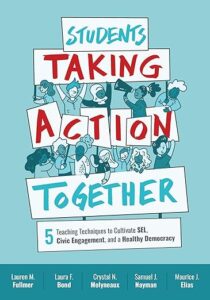SEL, Civic Engagement, & a Healthy Democracy
Students Taking Action Together: 5 Teaching Techniques to Cultivate SEL, Civic Engagement, and a Healthy Democracy
By Lauren M. Fullmer, Laura F. Bond, Crystal N. Molyneaux, Samuel J. Nayman, and Maurice J. Elias
(ASCD, 2022 – Learn more)
Reviewed by Katie Durkin

Students were asked to consider a social justice issue that is affecting people globally and use the United Nations Sustainable Goals to come up with a solution to a problem that may exist related to social justice.
Students had a great time researching different countries around the world as they learned about how women’s rights, climate change, racism, and the refugee crisis (to name a few) were affecting people worldwide. But even though students had a great time and came up with amazing solutions to take action, I felt like something was missing.
Accessing the missing elements

Students Taking Action Together begins with a short introduction stating the purpose of the book and making explicit the connection between democracy and education. The authors provide readers with an overview of the whole book as well as the resources included throughout the text.
The first chapter focuses on a brief overview of the STAT (Students Taking Action Together) teaching techniques. These five techniques are Norms, Yes-No-Maybe, Respectful Debate, Audience-Focused Communication, and PLAN, which stands for Problem definition, Listing options, Action plan, and Notice successes.
These chapters provide readers with the information to justify the need for and implementation of these strategies, and they set the foundation for what readers learn in the rest of the text.
Deep looks into the five strategies
After the introduction and first chapter, there are chapters devoted to each of the five STAT strategies. In each chapter the authors provide a clear explanation of the strategy followed by the details of how to plan and implement a lesson. This is a part of the book I really appreciate because it shares real-life examples about how the strategy worked in a classroom, helping me to envision how the strategy could work in my own space.
The authors follow up with information about how teachers can plan for and implement each strategy while also considering ways in which the strategy can extend their practice. I also like how the authors provide ideas for troubleshooting each strategy and include reflection questions at the end of the chapter to push readers’ thinking.
Many of the chapters also offer readers ideas for formative assessments for each strategy. The book also provides tables with checklists or ideas for student and teacher self-assessment.
The last three chapters of the book provide a roadmap that focuses on integrating the STAT strategies across the curriculum and in the inclusion classroom, and also how to bolster the implementation of STAT in your school or community.
The last chapter is particularly provocative as the authors provide frank guidance to teachers, school leadership, and parents for making STAT a part of their school community. I appreciate the authors’ honesty in these chapters and the way they have carefully considered how STAT can become a reality for schools while ensuring that students and their needs are being put first.
Plentiful supporting resources
There are also myriad features throughout the book and available to teachers online that I think are noteworthy. First, there is an extensive appendix that provides teachers with matrices for lessons that employ the STAT strategies, full sample lessons with extensive resources, lists of relevant teaching tips, and suggested further reading.
The authors also include an appendix about how to talk to your colleagues, parents, special services, or administrators about the STAT strategies. My favorite appendix offers teaching tips – it’s a one-stop shop for a teacher who wants a quick review of a particular strategy before using it with students.
Second, the authors developed a companion website that provides readers with extras that are discussed in the text. There are ready-to-use worksheets available for teacher and student use. Finally, throughout the book the authors provide tips for teaching using content from the companion website, increasing its value.
The authors also include connections for social-emotional learning throughout the book, helping readers to make the direct connection between the teaching techniques and SEL competencies. All of these features enhance the text and provide readers with more than enough information and resources to make it easy to begin using the five STAT techniques in their classroom and school.
Pairing design thinking and STAT
I think this book would work well with any unit that incorporates design thinking. I found myself constantly thinking about how these 5 STAT strategies mirror or complement the elements of design thinking. Even though the name of the book expresses the idea of taking action now, design thinking and the 5 STAT strategies can work in tandem to help students think about how they can take informed action in the future as well.
At their core, the 5 STAT strategies focus on building and maintaining democracy, and while this idea is usually relegated to Social Studies, Literacy or English Language Arts classrooms, the authors provide ample ideas for other disciplines to incorporate STAT.
This is a book I wish I’d had the day after January 6, 2021. This is a book I wish I’d had the day after the school shooting in Uvalde, Texas. This is a book I wish I’d had for countless events that have happened in our nation and around the world since I began teaching, but I am glad I have it now.
A book to share with colleagues
I recommend this book be read with a colleague, team, or department, regardless of discipline. It really is a book meant for every educator and a book that is a call to action. If we are thinking about the future of education, and arguably our nation, we want students who are going to be active citizens and strong contributors to our democracy. This book helps readers to think about ways to cultivate environments that emphasize social-emotional learning alongside civic engagement.
I also believe that this book will help teachers feel more comfortable with discussing controversial topics in their classroom, as well as offer a rationale for administrators or parents who may have concerns about such discussions. I am so excited that I read this book, and I have already begun to try out some of the STAT strategies with my students!
Dr. Katie Durkin (@kmerz610) has been teaching middle school students for over a decade, and currently teaches English Language Arts at public Middlebrook School in Wilton, Connecticut, where she is the 7th Grade Team Leader.
Katie is a zealous reader of middle grade and young adult books and enjoys sharing her love and passion for reading with her students. In 2022 she earned her doctorate from Northeastern University, where her dissertation research examined the impact of classroom libraries on middle school students’ reading engagement.
Katie was the 2020 recipient of the Edwyna Wheadon Postgraduate Training Scholarship from the NCTE. She writes regularly for MiddleWeb and in early 2023 launched a podcast, That’s Novel Reading.




























